 Back
Back
 Back Back |
Home > Advisor View > Reports > Dynamic and PDF Reports > Performance Calculations and Transaction Display > Exclude Cash or Other Securities from Performance
|
Exclude Cash or Other Securities from Performance
There are times you may choose to exclude a security from performance reporting. Perhaps a client has holdings you don't manage, and you don't want to include those returns with returns from securities under your management. Or your firm doesn't include cash in performance. For cases like this, Tamarac allows you to exclude one or more securities from performance reporting in one account or all accounts globally.
When you exclude a security from performance, Tamarac classifies it as an unmanaged asset. Many reports provide specific controls for handling unmanaged assets. For more information about how reports display unmanaged assets, see How Reports Handle Unmanaged Assets.
To control how Tamarac displays cash securities on performance reports, see Cash Settings.
This page provides steps for how to exclude any security, including cash, from performance.
If there's a security your firm always excludes from performance, you can exclude that security globally. For example, if your firm never includes cash in performance, you can exclude cash securities from performance for the entire firm.
To globally exclude a security from performance:
On the Setup menu, click Securities.
Click the name of the security or securities you want to exclude from performance. For information on using the Securities page, see Using Views and Filters on the Securities Page.
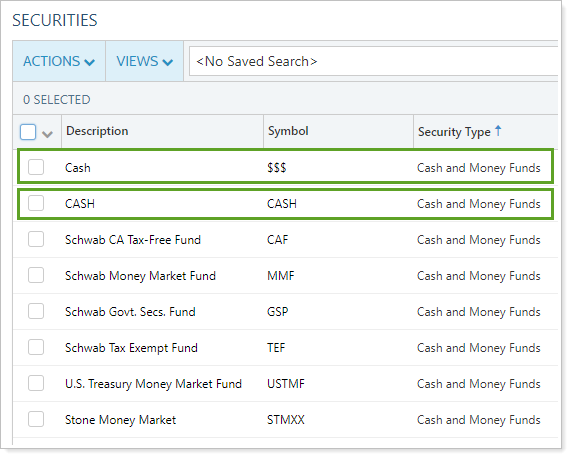
If you want to exclude all the securities in a specific Security Type, click the Security Type column to group together all the securities of each type.
Use multi-edit to exclude multiple securities at once: Click the check box next to each security, and in the Actions list, choose Edit.
On the Reporting tab, select Globally exclude from performance.
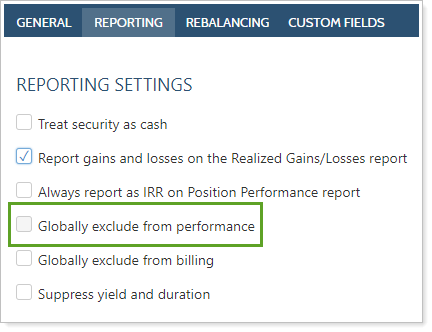
Click Save.
You can exclude a particular security from performance for just one client. For example, if your client has legacy holdings that you don't manage, you can exclude those holdings from performance so those returns aren't included along with returns for holdings you control.
To exclude a security from performance for one particular account:
On the Accounts menu, click Accounts.
Click the name of the account containing the security you want to exclude from performance.
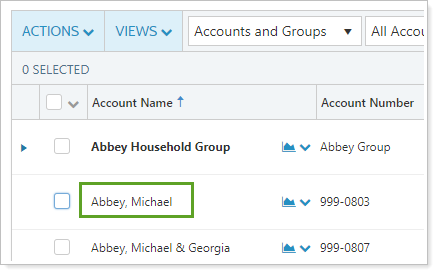
On the Reporting tab, click Excluded Securities.
In the Search securities box, search for the security you want to exclude and click Add Security.
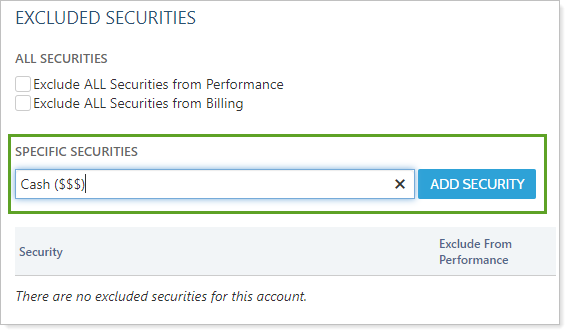
Select Exclude From Performance. If you still want to bill on the security, make sure to clear Exclude from Billing. For more information, see Maintaining Accounts: The Excluded Securities Panel.

Click Save.
When you exclude all the securities in an account, Tamarac marks the entire account as unmanaged.
For example, you might do this for a client's 401(k) account. It's helpful to show clients their 401(k) accounts in their Net Worth report, but since you don't manage that account, you wouldn't want to include the 401(k) returns along with returns for accounts you do manage. To excludes an entire account from performance reporting, you can exclude all securities in the account.
To set an account as unmanaged:
On the Accounts menu, click Accounts.
Click the name of the account containing the security you want to exclude from performance.

On the Reporting tab, click Excluded Securities.
Select Exclude ALL Securities from Performance.
Exclude ALL Securities from Performance excludes all securities currently held, all securities that were previously held based on historical transactions, and all new securities added to the account.
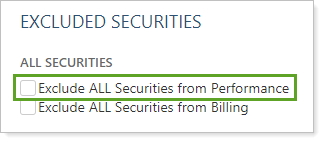
Click Save.